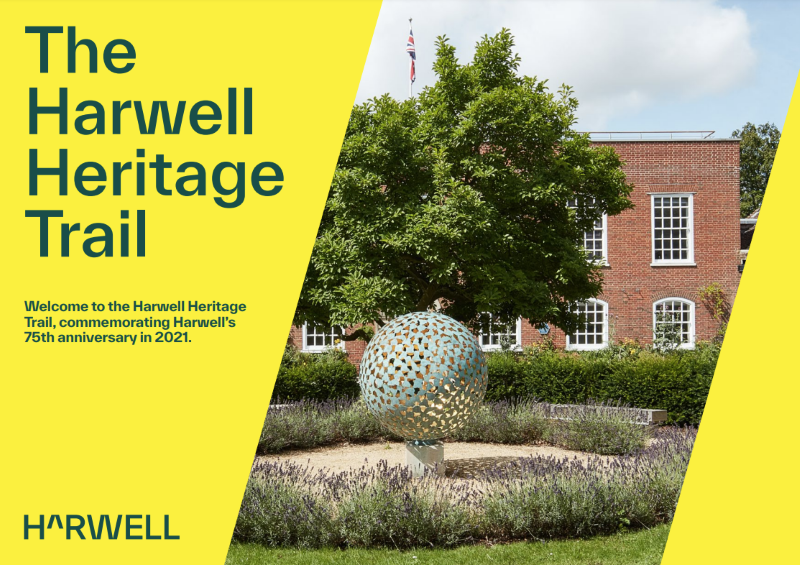The Harwell Heritage trail commemorating Harwell’s 75th anniversary. It is a 13 waypoint trail along a 4km circular route which will take approx. 60-90 minutes on foot.
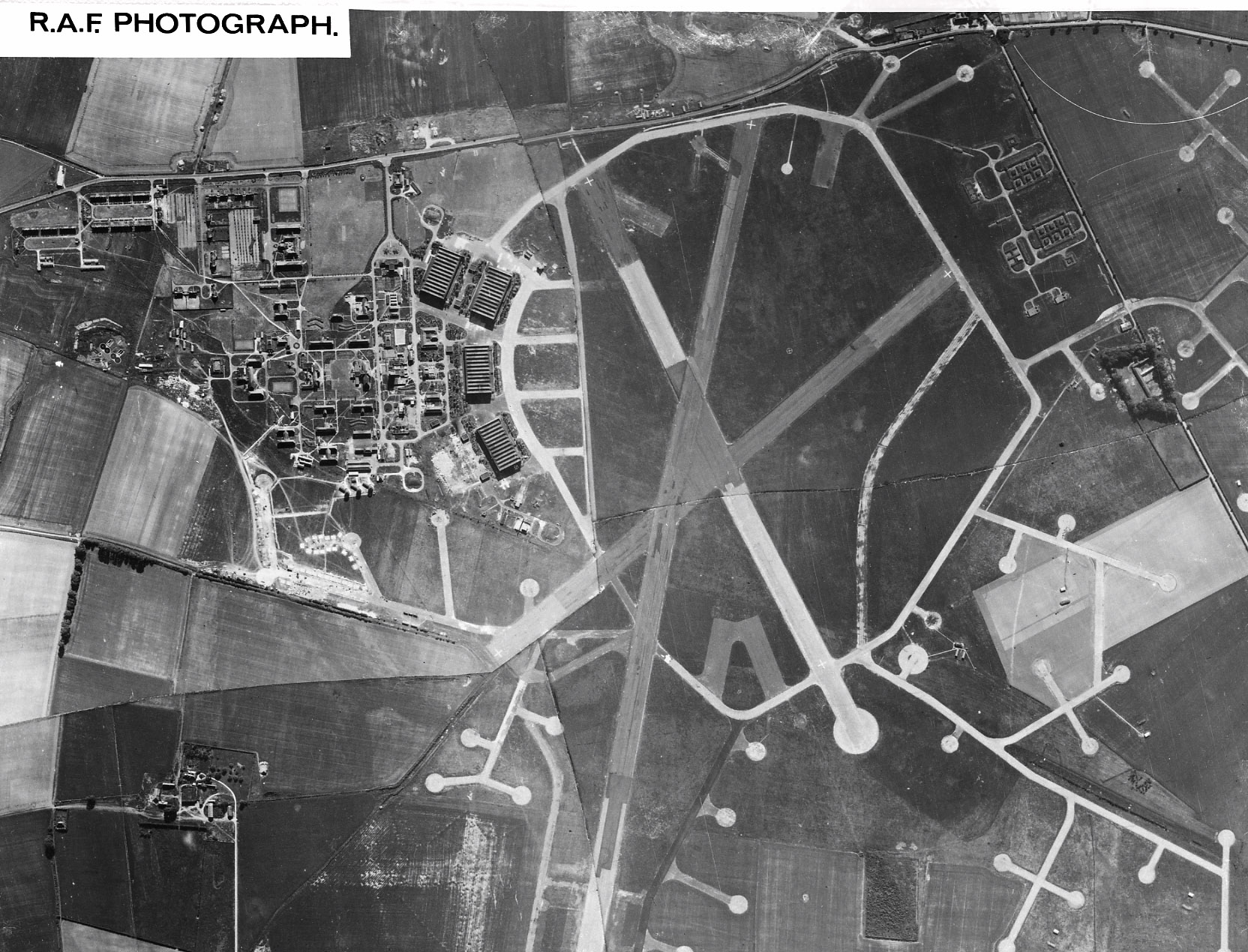

RAF Harwell
Way point #1 Harwell War Memorial
Welcome to the first stop on the Harwell Heritage Trail, comprising 13 information waypoints along a 4km route that will take approximately 1.5 hrs on foot. Following the trail, you will discover more about this fascinating place, some of the extraordinary discoveries made here and the people who have used science, technology, and engineering to improve the lives of millions of people around the globe.
Harwell is one of the world’s foremost research campuses, a place where the invisible is made visible, using some of the most advanced scientific instruments and facilities in the world. It is also a ‘living laboratory’ which means we adopt, test and deploy many of the latest technologies available, including driver-less cars on campus so that innovative solutions can be rolled out across the UK and abroad.
Harwell is home to the UK’s newest National Quantum Computing Centre and National Satellite Test Facility, alongside many other organisations contributing their knowledge to every human problem, from cleaning up space debris to keeping us all healthy. Soon the Natural History Museum will be moving a few of its precious collections here.
Harwell was originally an RAF airbase and was built by John Laing’s civil engineering company in 1935, the first of 66 airfields to be delivered nationally for the Ministry of Supply at the start of the Second World War.
In 1944, RAF Harwell played a major role in the UK’s preparation for the invasion of occupied France, as part of the D-Day landings, part of the main ‘Operation Overlord’ military offensive. Stationed at RAF Harwell, the 38 Group RAF, 6th Airborne Division and the Glider Pilot Regiment were among the first to participate in Operation Overlord, on the eve of D-Day itself in a mission called ‘Operation Tonga’. Their order was to ‘capture intact the two bridges of the Orne and the canal of Caen, Bénouville and Ranville’, (later re-named the Pegasus and Horsa Bridges), in a strategically vital operation known as ‘Deadstick’.
On 5th June 1944 six Armstrong Whitworth Albemarle aircraft towing Airspeed Horsa gliders flew Pathfinder Paratroopers from RAF Harwell to Normandy to illuminate Drop Zones and capture the bridges. Waves of aircraft carrying troops, including Stirling IV bombers took off through the night from RAF Harwell and across the UK. Many would never return.
General Gale unveiled the Harwell Memorial on 14th May 1955 and a service of commemoration is held here annually by the Harwell British Legion. Sir John Cockcroft, Nobel prize-winner and Harwell’s first director, pledged to maintain the memorial and Garden of Remembrance to commemorate Harwell’s important part in the liberation of Europe.
%20-%20Copy.jpg)
Thomson Avenue
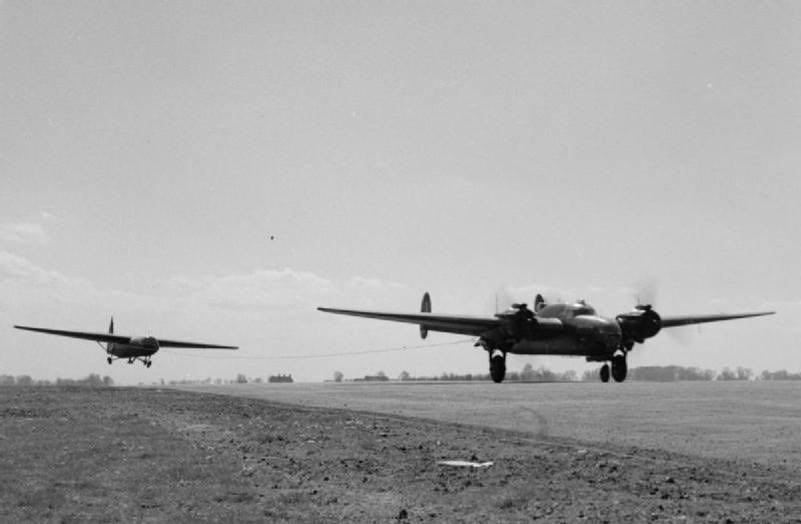
RAF Harwell
-1.jpg)
Thomson Avenue
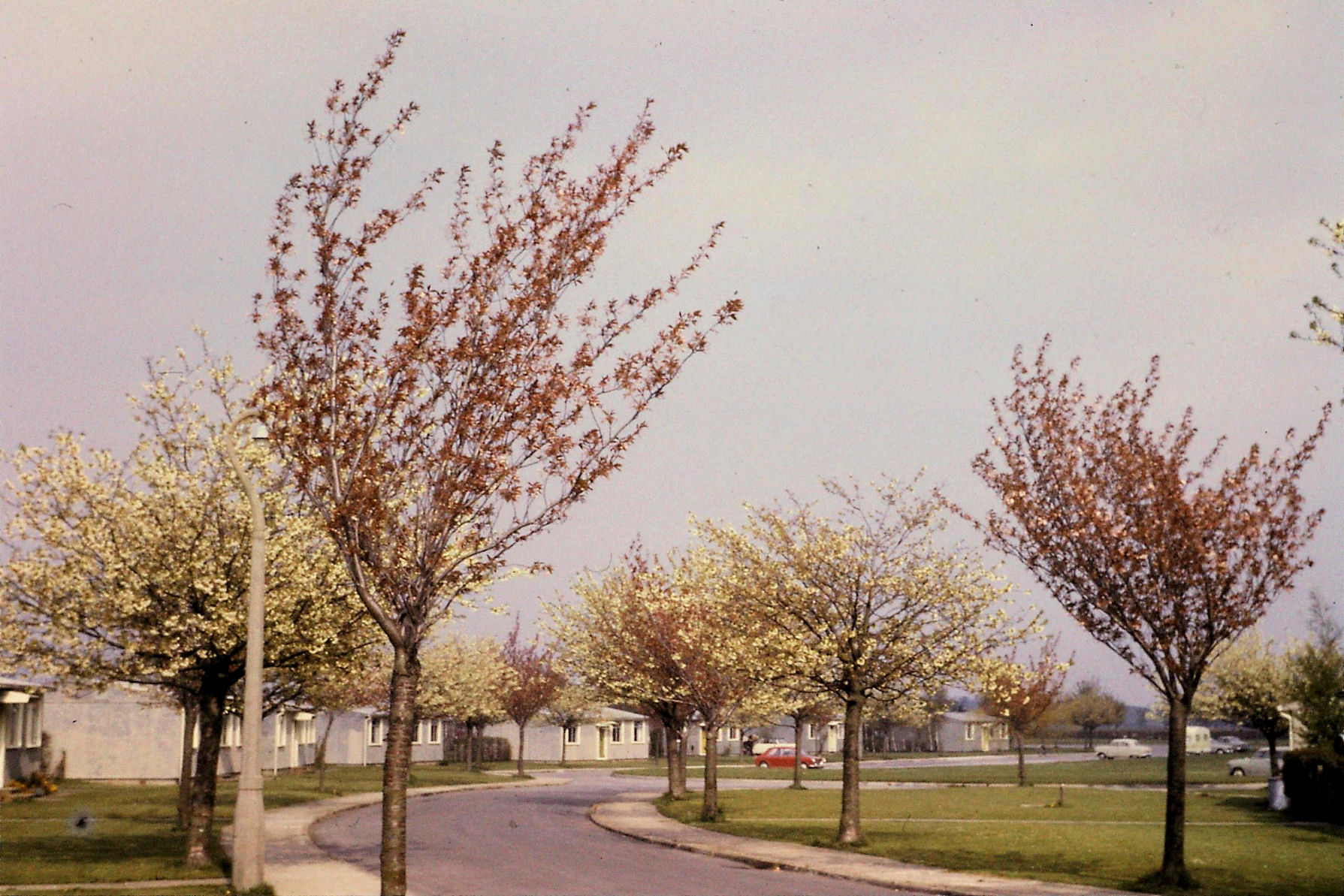
.jpg)
Creating Science Town
Way point #2 Thomson Avenue
You are now at the second trail stop, and you are standing close to the former Main Gate to the AERE (Atomic Energy Research Establishment) Harwell, at the end of Thomson Avenue named after J.J. Thomson who discovered the electron in 1897 and later formulated the ‘plum pudding model’ to help describe what scientists knew about atomic structure at the time. From the 1940s until the early 2000s it provided secure access onto the nuclear site and everyone, including the Director, had to show their pass. Construction work started in 1946 to convert the RAF base into a secret scientific establishment to research nuclear energy, but because there was a Cold War with Russia there were no signs saying “Harwell” anywhere. The builders were W E Chivers & Sons, so its nickname locally was “The Jam Factory” after a well-known brand of jam. A book by author Nick Hance entitled ‘Harwell - The Enigma Revealed’ tells the detailed history of Harwell and is credited as contributing towards the Harwell Heritage Trail information.
To the south of AERE Harwell is the Rutherford Appleton Laboratory (RAL), named after two Nobel Prize winning physicists, Ernest Rutherford, and Edward Appleton. Rutherford studied radioactivity and with his concept of the nuclear atom, led the field of nuclear physics; he was awarded the Nobel Prize for Chemistry 1908. Appleton won the Nobel Prize for physics in 1946 and established the existence of the ionosphere layer of the earth in 1927 which later aided the development of radar. In 1957, the Rutherford High Energy Laboratory (RHEL) was established as part of the National Institute for Research in Nuclear Science (NIRNS) to manage a linear accelerator for use by research groups across the country.
Harwell is the size of a small town, with its own police force (The Civil Nuclear Constabulary) and formerly, its own fire brigade, plus the all-important refreshment van, which was affectionately known as ‘The Bun Wagon’. Until the late 90s, Harwell employees mostly used public transport, bicycles, or travelled by foot for their daily commute to work. 50 or more distinctive blue and grey AERE double decker buses would pass through these gates, delivering some 6,000 people who would support the important atomic energy research and other ground-breaking scientific work taking place at Harwell.
East - west roads at Harwell were named avenues, after famous scientists including Fermi, Becquerel Curie, Rutherford, and Thomson Avenues and those running north from an avenue were even-numbered streets such as ‘Eighth Street’, similar in format to US cities. There are also roads named Avon, Dido, Frome, Severn and Thames as well as North and South Drive where former RAF officer’s homes were and these will soon make way for new residential homes at the northern end of the campus.
Harwell Campus has a growing number of people working on campus today, once again numbering over 6,000 people working inside 200+ organisations and with over 65 nations represented. However, they are engaged in a much wider array of scientific disciplines than in the early days, building on Harwell’s nuclear heritage. Many still commute in by Science shuttle-bus, local buses and bicycles as a greener way to travel to work and the Darwin project at Harwell is currently trialling a special electric powered, autonomous vehicle that can be spotted gliding quietly around campus.
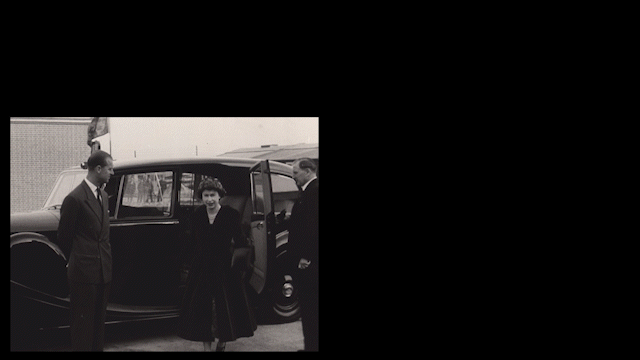
Harwell’s discoveries power tomorrow’s world
Way point #3 Quad Café and Fitness Studio
You have reached your third trail stop where we will electrify your understanding of batteries. The Faraday Institution HQ is located inside Quad One building and is funded by the UK Government to fast-track commercially relevant battery science and technology, speeding up the electric revolution towards a cleaner world. Nearly 500 researchers across the UK are working on Faraday Institution projects to improve current generation and invent next generation batteries that are better performing, lower cost, lighter weight, more sustainable and fully recyclable.
Work on batteries was conducted at Harwell from the early 1980s when a scientific exploration team and the University of Oxford, under the leadership of American physicist John B. Goodenough led to the early concepts of the lithium-ion battery being developed here, now used in everything from mobile phones to electric vehicles.
Goodenough’s work followed on from Ford Motor Company’s early work on the sodium-sulfur battery which succeeded in increasing the energy density in a battery cell. His work helped batteries to become lighter, more portable and enabled them to be re-charged, a great step forward in conserving materials and storing energy for longer periods of time. After attempting to patent his special cathodes, Goodenough could not find a company to assemble the battery, so he gave the patent to the AERE Harwell Laboratory and later Sony invested in the concept to take it to market. In 2019, John B. Goodenough won the Nobel Prize for Chemistry for his work developing lithium-on batteries, sharing the prize with M. Stanley Whittingham and Yoshino Akira. The lithium-ion battery is now in common use everywhere in the world.
Father and daughter, Griff & Teresa lived and worked at Harwell
Hear them reminisce on their days at Harwell
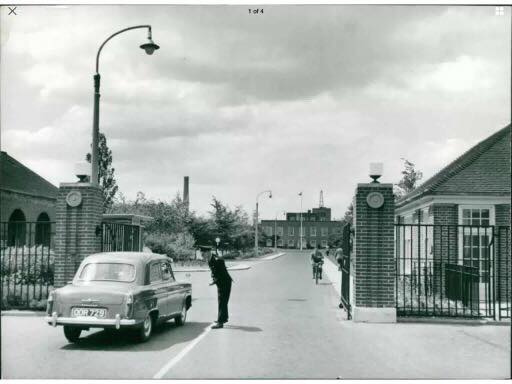
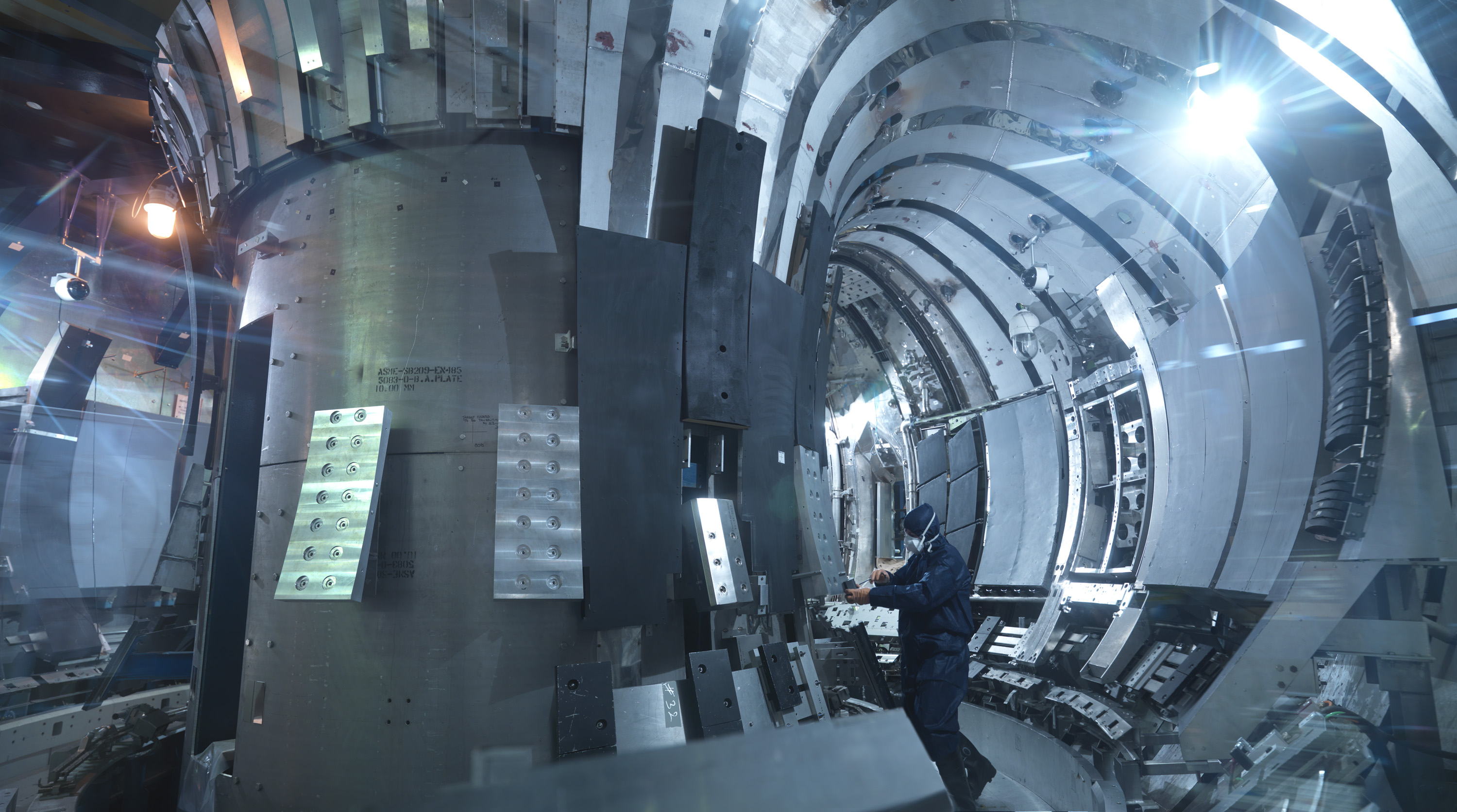
The 'Atomic village' at work and play
Way point #4 Second Street
Welcome to Second Street, at the very heart of Harwell Campus past and present. Behind you is the ‘HQ Building’ where you may have noticed a historic blue plaque and RAF insignia, which was formerly the Headquarters of RAF Harwell in the 1940s and later the HQ for AEA Technology (Atomic Energy Authority). The AEA was set up to de-commission the nuclear facilities at Harwell, making way for a science and technology campus that would provide a home for many more exciting businesses, spanning space industries, life sciences, energy, and the environment.
Travelling back in time to 1944, the Government created a blueprint for an atomic energy research establishment and Harwell’s site was chosen. The reason for this was that it was simpler to adopt an RAF airfield than start afresh, as it had the existing infrastructure needed including roads, water supply and aircraft hangars to contain nuclear equipment. It was also located relatively closely to the universities of Oxford and Cambridge, the source of many of the experts who would participate in future research programmes.
The Air Ministry handed over the site on 1st January 1946 and in 1954 it was placed under the control of the Atomic Energy Authority. Sir John Cockcroft, AERE Harwell’s first Director, was challenged to create the entire nuclear fuel cycle encompassing new areas of scientific discovery. Later Walter Marshall, Director of Harwell in 1974 commercialised the site, enabling Harwell to open to an exciting array of R&D, engineering, and other innovative organisations.
Coined in early Pathé news footage as the ‘Atomic Village’ in the 1940s and formally known as AERE (Atomic Energy Research Establishment) Harwell, the site originally belonged to Berkshire before the county boundaries changed to Oxfordshire in 1974. The site almost doubled the local population and by 1985 employees travelled from towns up to 20 miles away, employing 6,000 workers across 100 buildings on site.
The campus today has given rise to the term ‘The Harwell Effect’, where the public and private sector work closely together and are invested in by the Government to create an eco-system of innovation, world-class science facilities and a place where industries and companies can conduct research, work, connect and thrive. Exciting crossovers can happen, for example where industrial diamond technology used for oil rig drilling equipment is now being used to help construct spaceships and satellites. Software mapping technology used to map the constellations in the universe was re-purposed to look closely at how cancer cells group and spread.
The cricket ground you can see from this vantage point was formerly the Berkshire Cricket Ground and is still used for cricket practice and matches today, as well as for the Harwell Rounders League where teams battle it out over the summer to win a coveted trophy.
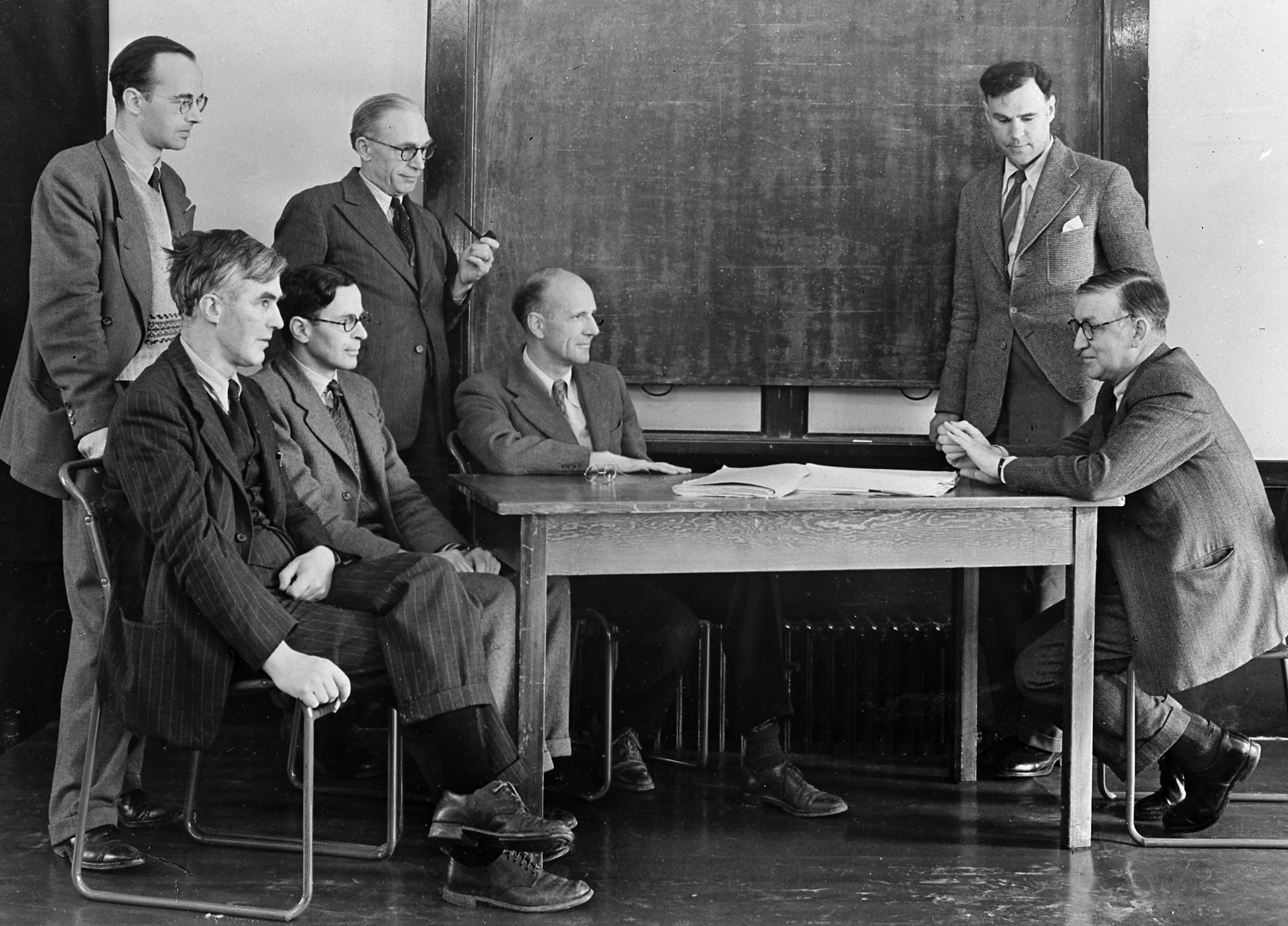
Klaus Fuchs
Way point #5 Harwell Innovation Centre
Harwell was once a top-secret establishment where staff had to sign the Official Secrets Act to work inside the facilities, a necessity to protect the vital scientific research being undertaken on site. A gifted scientist, mathematician and computer developer, a man named Klaus Fuchs applied for a job at Harwell in 1946, and although he was known to have been a pre-war communist sympathiser, he became Head of the Theoretical Physics Division as a Principal Scientific Officer. In 1947 he lived at No. 17 Hillside, in one of the prefabricated homes that were erected at Harwell to house workers during the war, and Klaus befriended and socialised with many of the people he worked with.
This was the era of the Cold War with Russia and in 1943 Fuchs had worked with Oppenheimer on the Atom bomb, codenamed the ‘Manhattan Project’. He passed secret information to the Russians about the full design of the ‘A-bomb’ and the development of the Hydrogen bomb via fellow spies Harry Gold, known as ‘Raymond’ and Agent ‘Sonya’ (real name Ursula Kuczynski). A book by Ben MacIntyre titled ‘Agent Sonya, Lover, Mother, Soldier, Spy’ tells her story.
In 1946 Fuchs’s job at Harwell gave him access to important research about nuclear and applied science which he shared with his spy contacts. Key people gradually became suspicious of him, and his espionage was eventually discovered in 1950, leading to his arrest and a confession of his spying activities to the War Office. Fuchs served 9 of 14 years imprisonment for his espionage crimes.
Knowledge leading to new discoveries and eventually commercial success, are prized assets and some of the Harwell’s work remains top secret today. Organisations developing new technology in today’s world use the term ‘Intellectual Property’ to legally protect their ideas and prevent industrial spies from stealing from them.
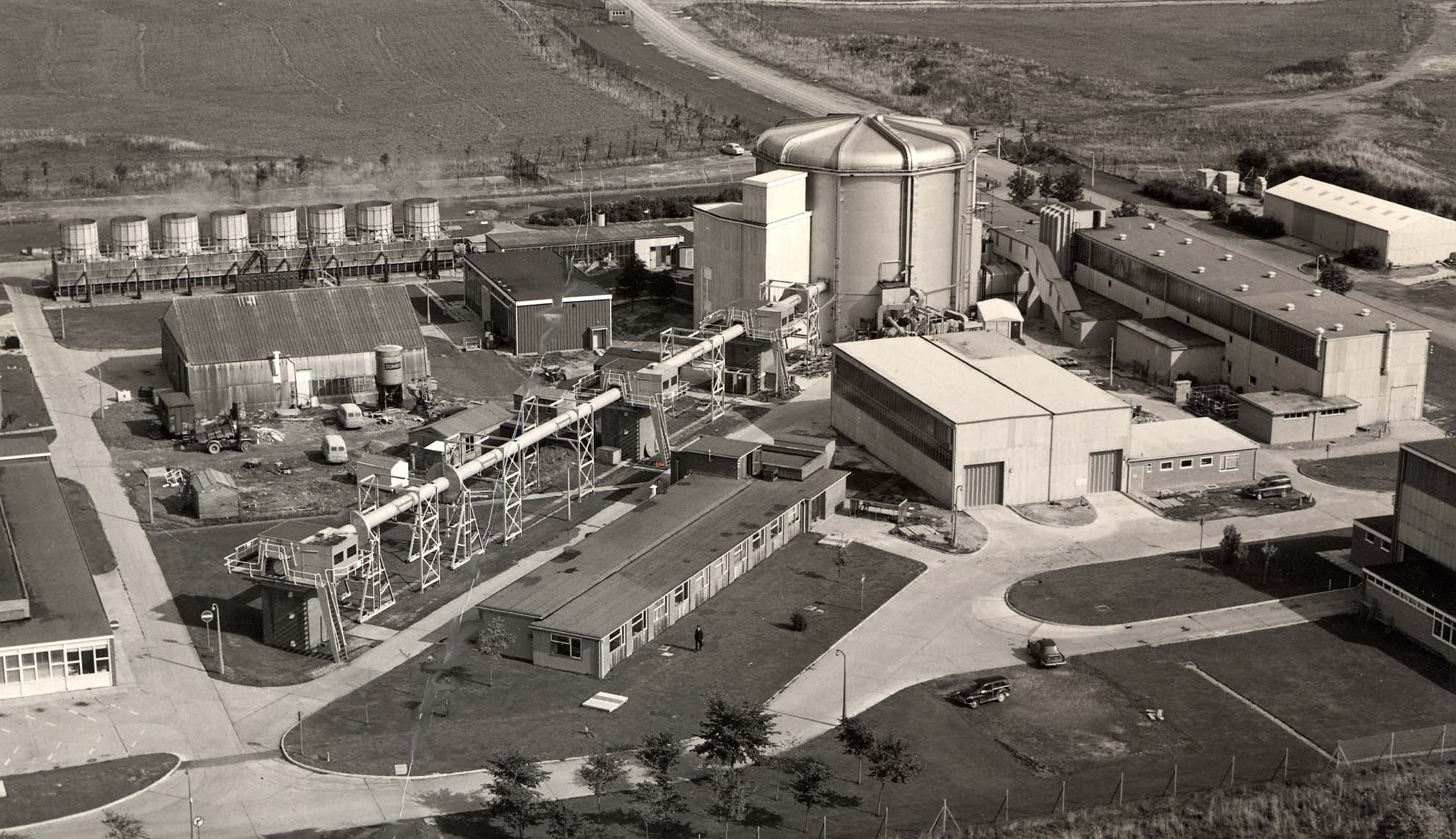
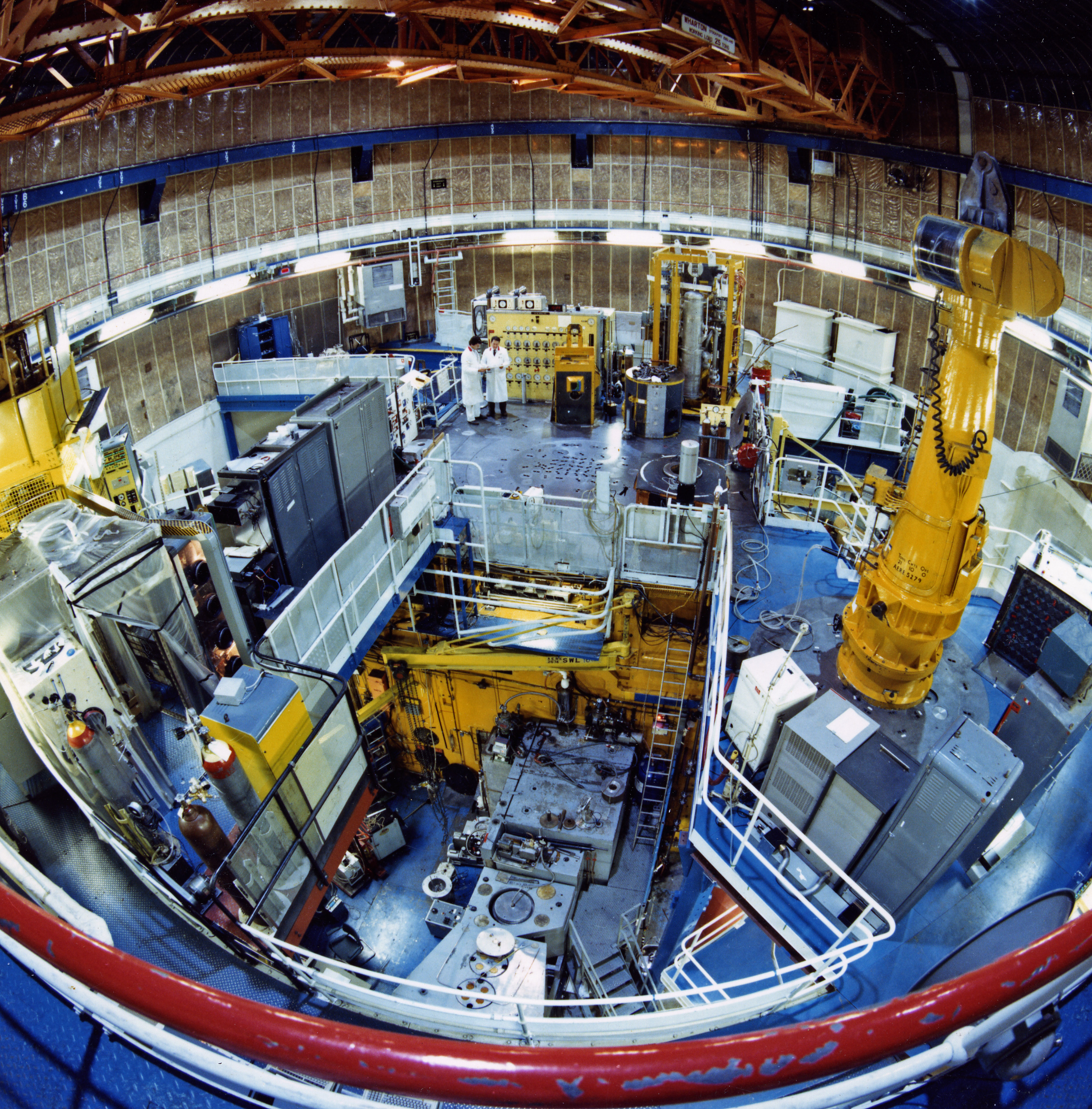
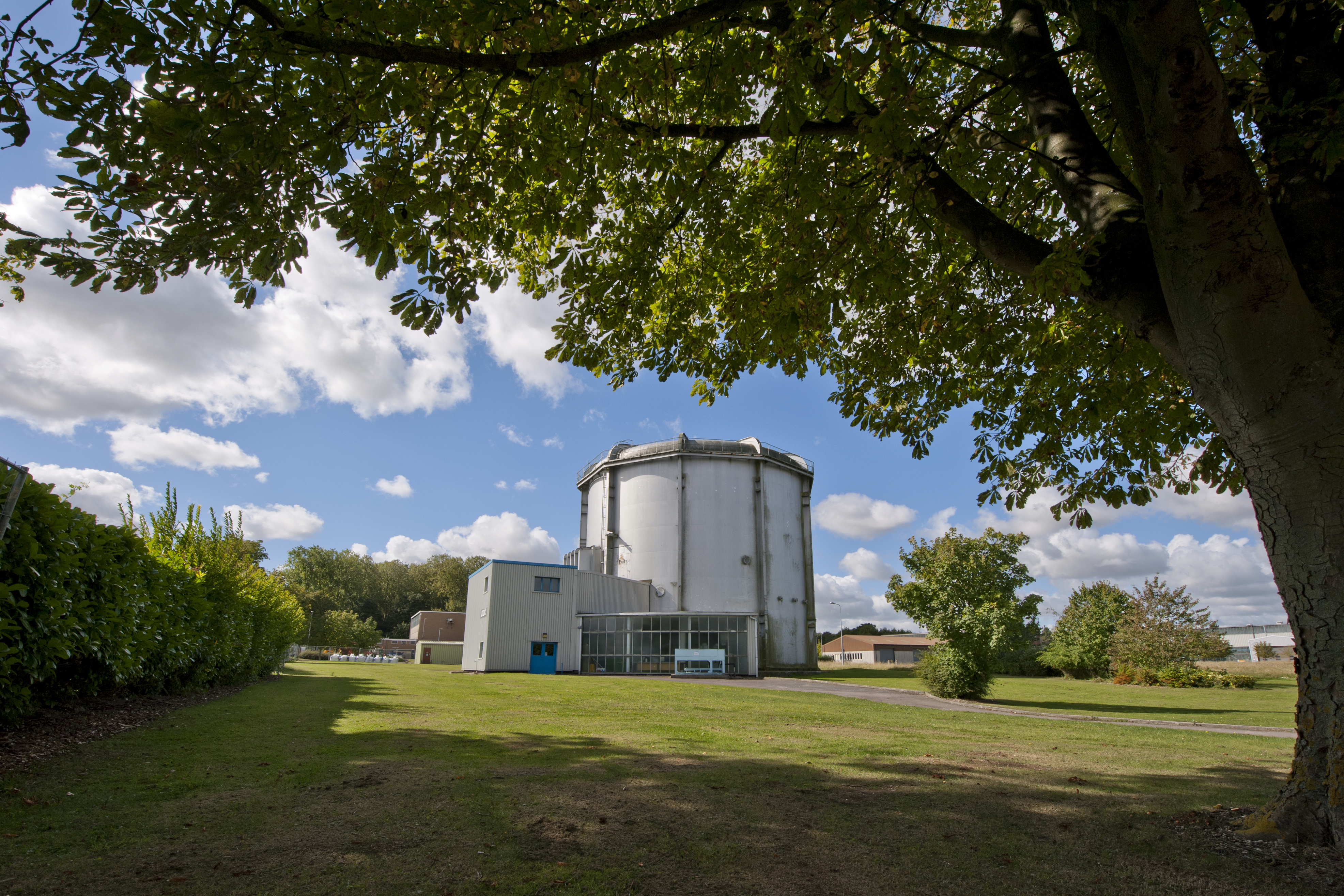
Harwell delivers Europe's first nuclear reactors, GLEEP and BEP0
Way point #6 Eighth Street
You have reached your sixth stop on the Harwell Heritage Trail where we will share details of Harwell’s early atomic research programme, seen to be the energy of the future, and at the time, more powerful than anything that had existed before.
In 1947 Harwell built Europe’s first atomic nuclear reactor ‘pile’, GLEEP (Graphite Low Energy Experimental Pile), made of graphite blocks and uranium rods, constructed by WE Chivers Engineering and costing £2.5m, the equivalent of £200m today. Early building work on GLEEP and later BEP0 (British Experimental Pile zero) took place in the arctic winter of 1947 and the reactors were partially built using war surplus materials such as armour plating from spitfire fighter planes. Hangar 10, formerly used to house wartime planes, had its roof raised to accommodate BEPO and bad weather delayed the project. Large holes were excavated in the ground underneath to build the foundations of the GLEEP and BEPO reactors, taking full advantage of the natural chalk soil to protect against radioactivity rather than surrounding the reactor with lead bricks.
GLEEP helped scientists to discover that magnesium was virtually transparent to neutrons, enabling metallurgists to manufacture a special aluminium alloy containing magnesium and beryllium, the material known as ‘Magnox’. This superior canning material for uranium fuel was used in the first phase of Britain’s nuclear power stations dubbed ‘Magnox’ stations. GLEEP ran successfully for 43 years before being de-commissioned in 1990 and was adopted by the National Physical Laboratory as an International Standard source of neutrons. A neutron is a subatomic particle of about the same mass as a proton but without an electric charge, present in all atomic nuclei except those of ordinary hydrogen.
These and later reactors with curious sounding names such as ‘DIMPLE’, ‘DIDO’, ‘ZEEP’, ‘ZEPHYR’ and ‘ZEUS’ mark the early days of Harwell’s exploration and research into future facing energy sources, paving the way towards renewable sources such as wind, wave and solar power that are increasingly being harnessed to fuel a cleaner, more sustainable world. Some of the new-builds at Harwell including Zephyr, Zeus and BEPO are named after these original reactors.
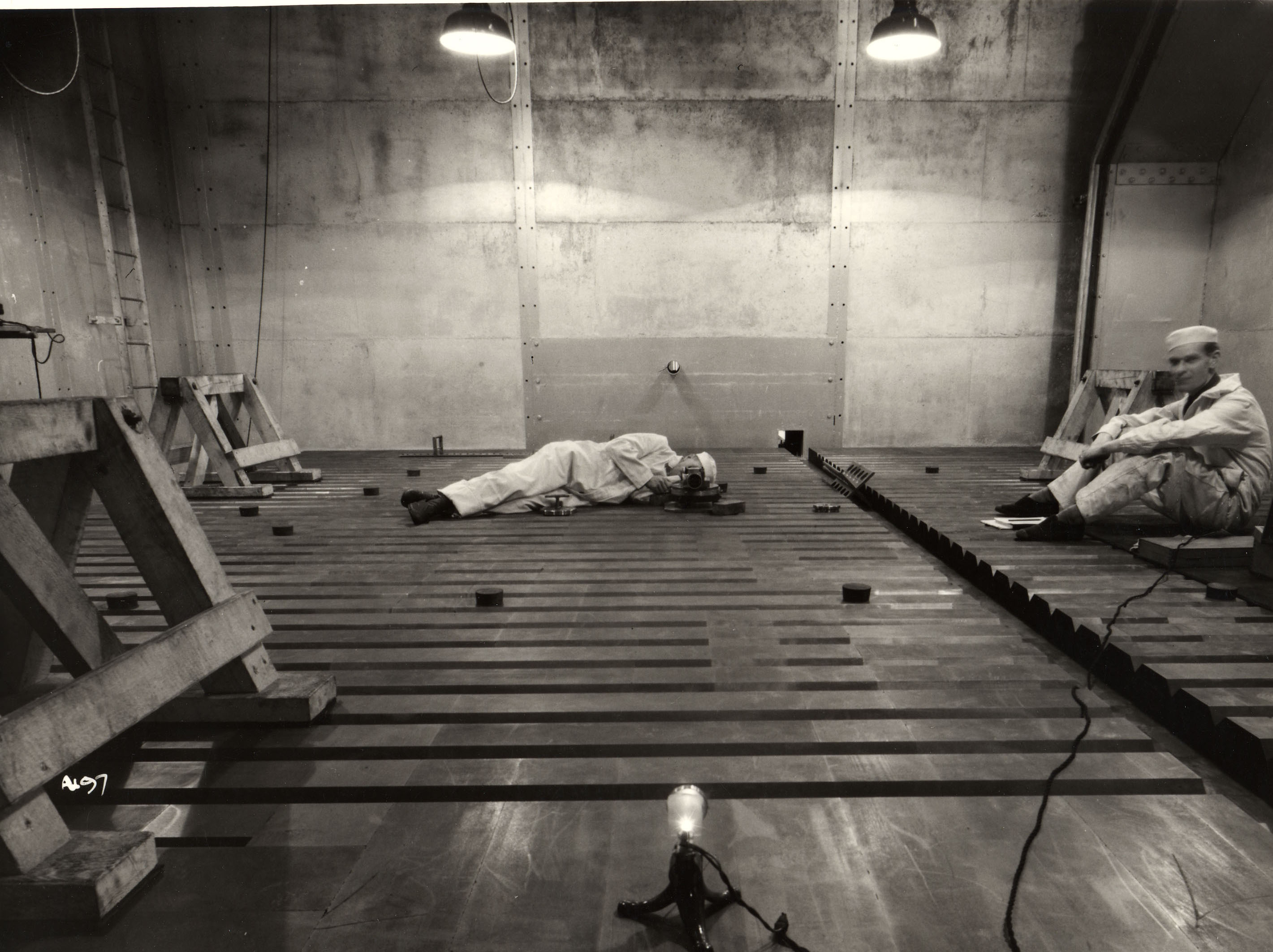
Construction of GLEEP reactor
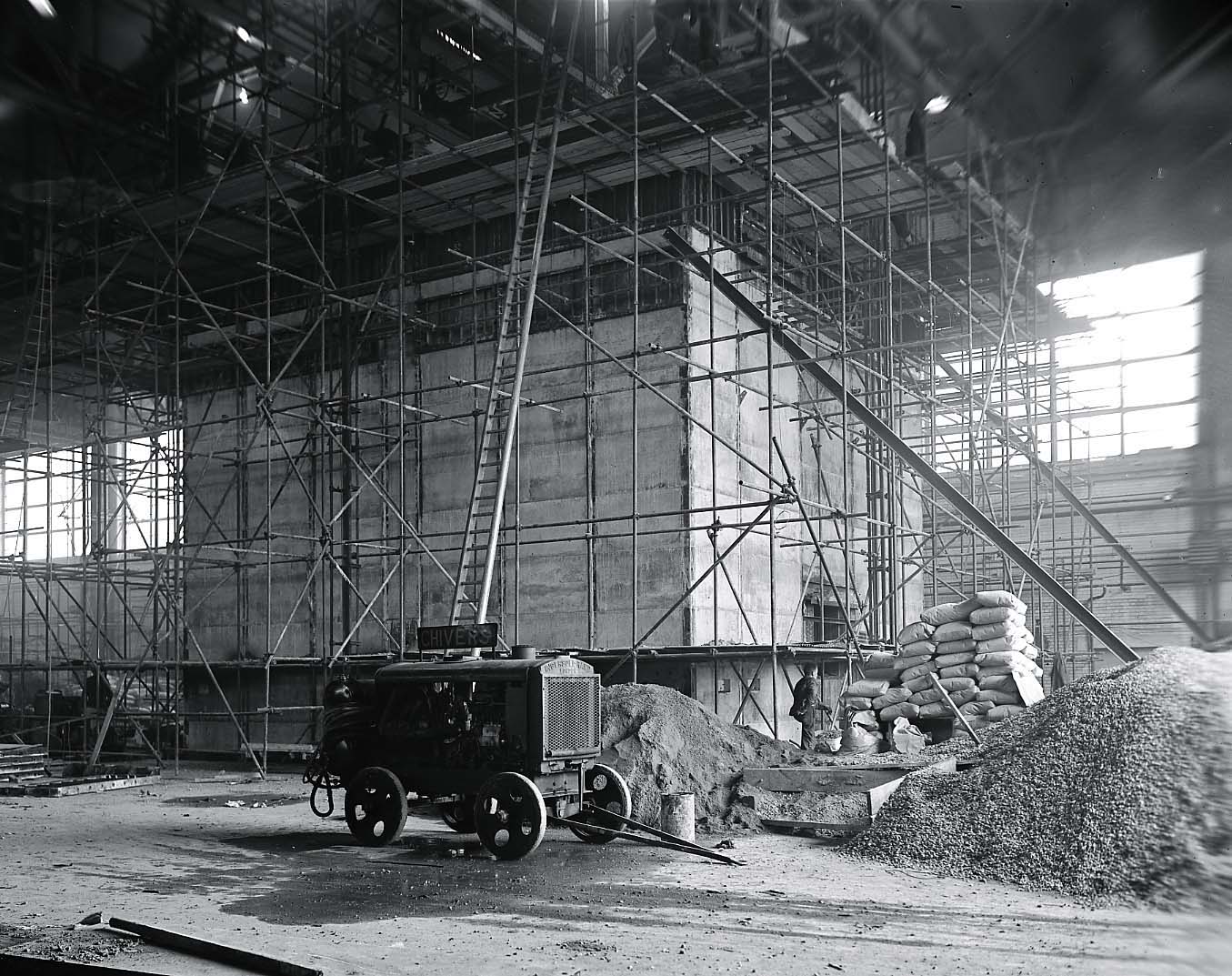
Construction of GLEEP reactor
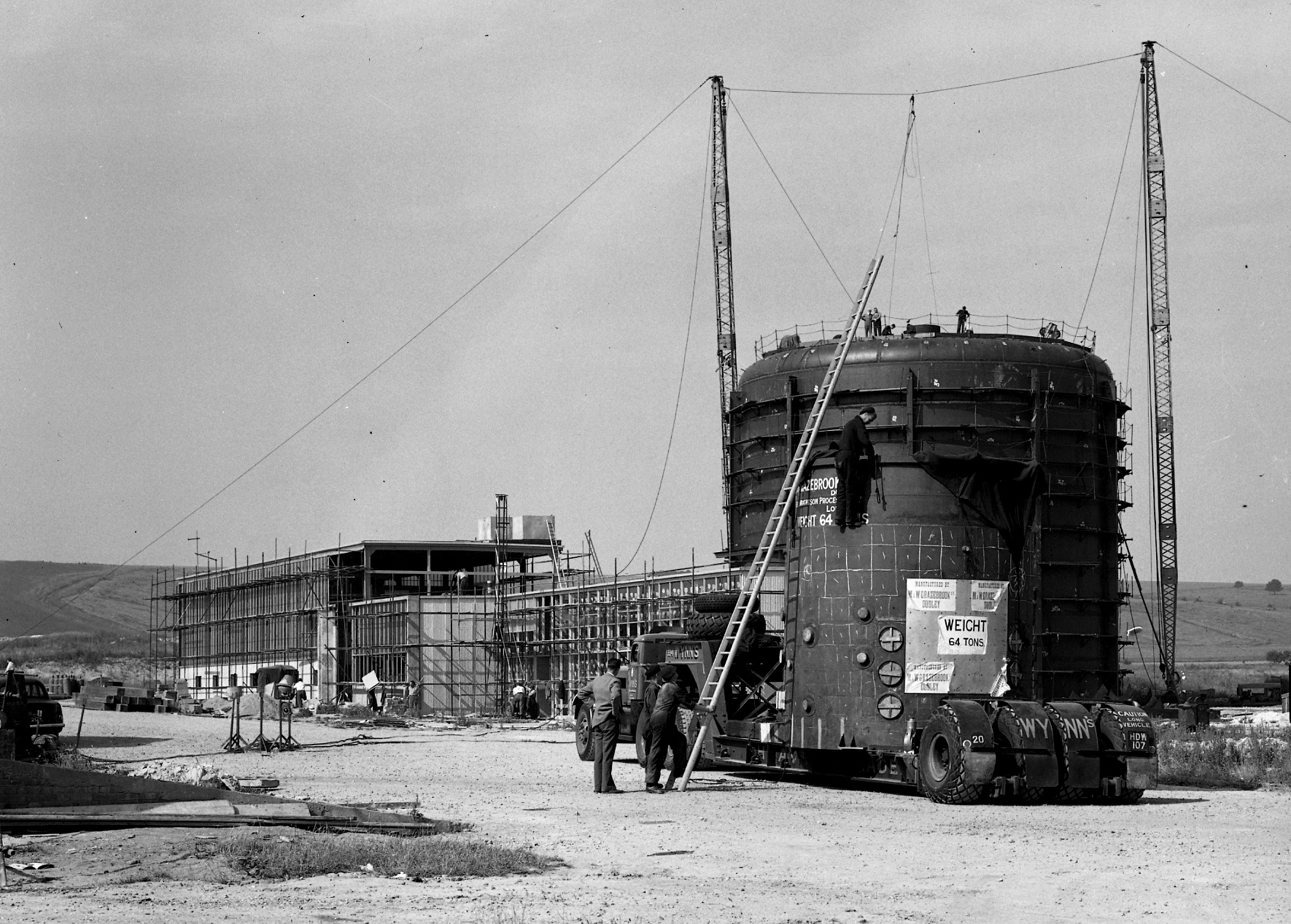
Construction of DIDO reactor

A shooting star lands at Harwell
Way point #7 R100 RAL Space Building
On 22nd April 1957, on a dark, wet evening, a dual seater T-33 ‘Shooting Star’ jet plane belonging to the US Airforce (USAF), took off from Kent, heading for Bournemouth. The crew suffered the loss of their compass and instrument failure, combined with a shortage of fuel and were lost in the growing darkness, looking for a spot where they could land safely.
They could see a place that had runways, large hangar buildings and a large red flashing light and thought they were above RAF Abingdon. Circling twice, they lined up in readiness to land on Fermi Avenue, touching down near the B 412 building (now R12), bursting two tyres whilst braking to avoid Easter traffic on the Newbury Rd, near the entrance to Fermi Avenue. The security staff on duty that evening rapidly scrambled to respond to this foreign “invasion.”
In the following days, rather than dismantling and removing the plane from the AERE site, a decision was made to attach a rocket to each wing to help it take off on a much shorter than normal runway. Watched by Harwell staff who witnessed a flame coming from the rocket, the take-off was attempted but something went wrong with one of the rockets and the left wing touched the ground. Luckily, a security fence acted as a net to slow the aircraft down but the remaining rocket powered it onwards, chased closely behind by the AERE ambulance and fire engine. The jet fighter went through another security fence, very close to the GLEEP reactor, tearing all three wheels and a booster rocket off, stopping just short of a pit being dug by contractors for the foundations of the new Tandem Generator.
Peter Reeves, a foreman for Chivers Engineering, bravely rescued the pilot from the aircraft and the fire crew sprayed foam over the plane to ensure it did not burst into flames due to the fuel tanks on board. Luckily, no one was hurt but much stricter flying restrictions were placed on the campus as a precaution afterwards. The runway used for planes on D-Day (now Frome Rd) and the large bus park were covered over to avoid pilots mistakenly thinking they were active runways. The Shooting Star was eventually retrieved by the USAF with the aid of a large trailer.
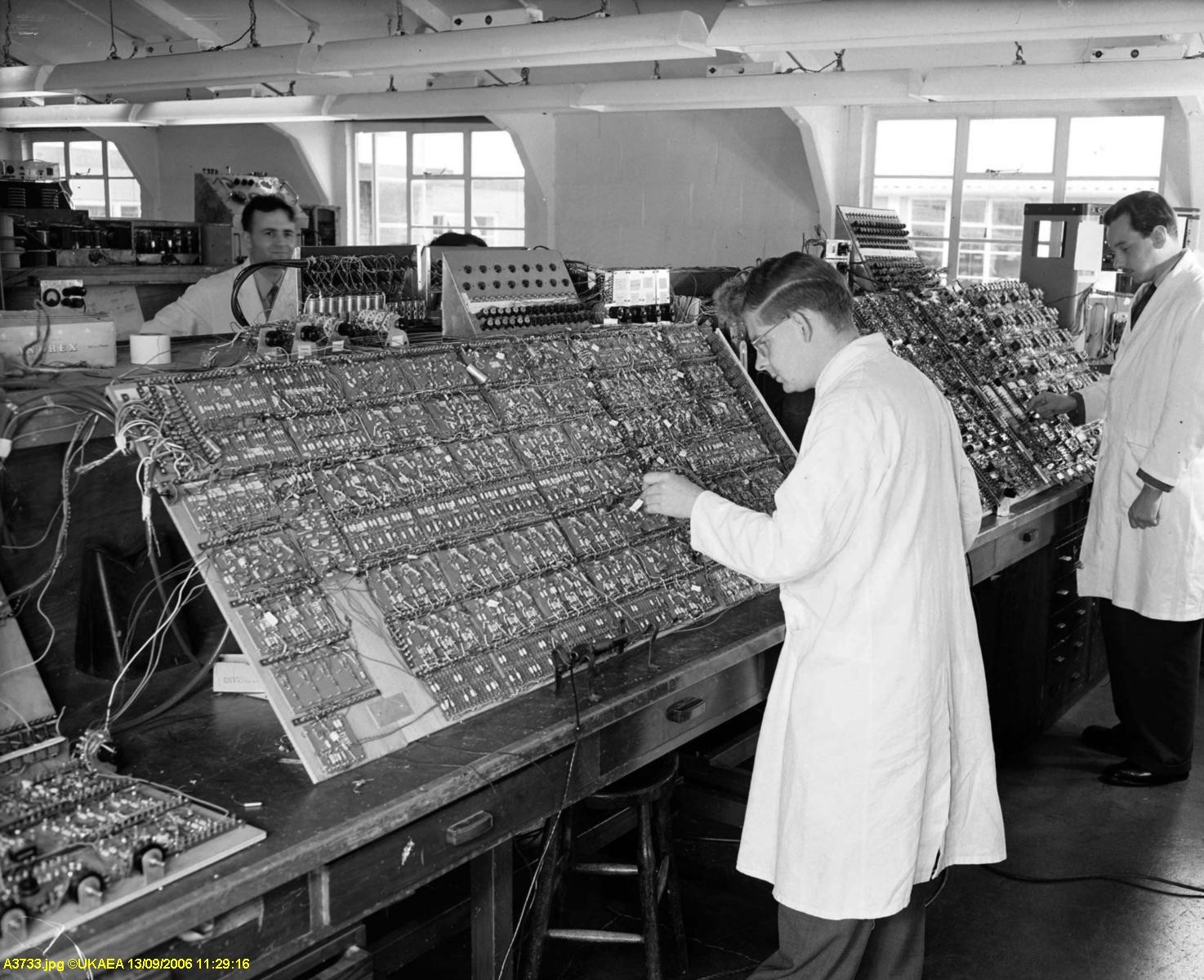
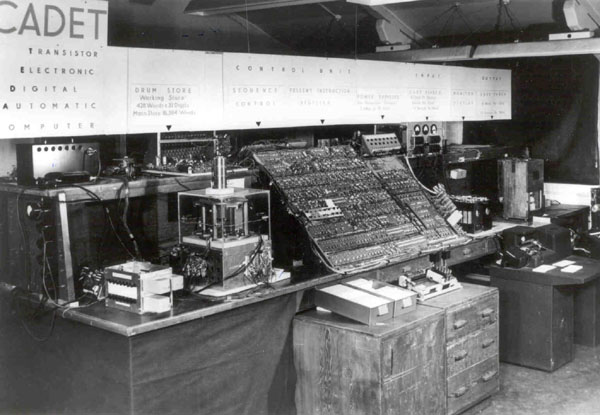
Revolutionising computing
Way point #8 Atlas Building
You have reached the eighth waypoint on the Harwell Heritage Trail where you will learn about Harwell’s contribution to the advancement of mathematics and computers, brought about to help scientists better understand the output of the experimental research they were doing.
The way scientists and support staff arrived at mathematical calculations in 1948 was a combination of manual computation using brainpower, logarithm tables, slide-rules, and noisy hand-cranked mechanical desk-top calculating machines. Greater computing power was needed to simulate nuclear experiments and analyse data which necessitated the creation of a dedicated electronics department at Harwell, tasked with sourcing and developing their own bespoke, ground-breaking computers.
In 1952 Edward (Ted) Cooke-Yarborough and the team from the National Physical Laboratory, assembled the world’s first all-transistorised computer, a prototype using 320 transistors named CADET (Transistor Electronic Digital Automatic Computer). Used as random-access memory it was much smaller than others of its type, taking up less than half a laboratory in area, which seems huge now compared to the power of a mobile Smart phone today. CADET was the first electronic computer in regular use in the UK and was capable of handling more complex computations, running for 10 years until it was overtaken by new, more powerful computers.
In 1961, Tom Kilburn at Manchester University and Ferranti Ltd designed and built the Atlas 1 supercomputer. Only three of these computers were built, but one, known as the “Chilton Atlas”, came here and was housed in the purpose-built Atlas Computer Laboratory. At the time, the Atlas 1 was the biggest, fastest, most powerful programmable super-computer in the world, used to perform simulations and analyse data for Rutherford’s linear accelerator and AERE Harwell’s reactors, as well as running programs for universities across the country.
In 1984, the Atlas and Rutherford Laboratories welcomed the CRAY-1 (X-MP) supercomputer which was the most powerful supercomputer in the world at the time, later upgraded to a CRAY-2 (Y-MP). In the 1990s, when the CRAY-2 computer was not in use, it was programmed to search for prime numbers and in March 1992 it discovered a rare number, one that was not only the largest prime number ever known, containing a quarter of a million digits, but also the largest Perfect number known, the 32nd Perfect number. This beat the previous US record Prime Number, discovered 7 years earlier.
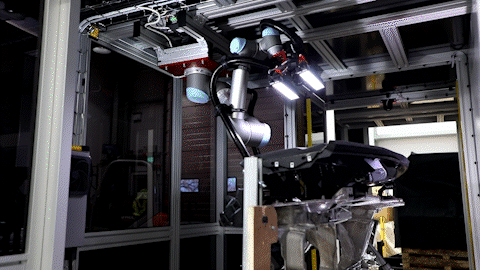
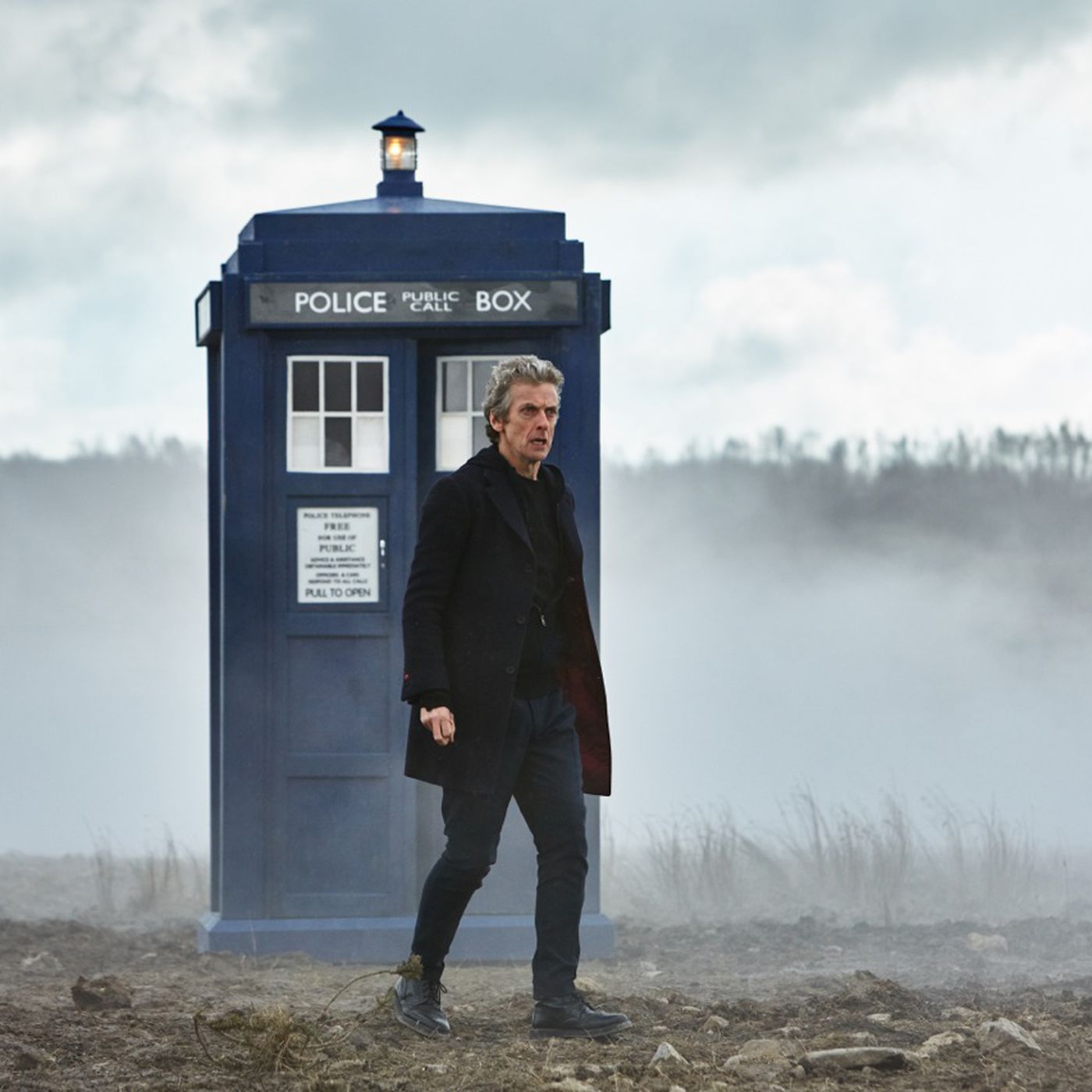
Great minds collaborate and Dr Who roams Harwell
Way point #9 Fermi Avenue
You are nearing the end of the Heritage Trail, with just four more stops to reach your destination and here we will share how Harwell helps keep us safe, from looking at new generation antibiotics to protecting the nation’s health. Where the arrow is pointing, you may glimpse the recently expanded Research Complex at Harwell (RCaH), which was founded in 2006 and sits beside the doughnut shaped Diamond Light Source facility. Research Complex is a centre for cutting-edge scientific research, supporting more than 200 scientists from over 25 UK universities and companies
Research Complex works closely with the other large-scale facilities at Harwell, and its mission is to bring together teams from universities and industry under one roof to work together to achieve outstanding science. It is the home of several key facilities including the Central Laser Facilities and HarwellXPS (advanced spectroscopy), providing specialist equipment for academia and industry to use, which means that researchers can achieve quality results very quickly. Examples of fusing different science disciplines together to achieve amazing science, include the production of electric cars and aircraft, generating environmentally friendly gases, developing smart windows that create electricity from sunlight and finding effective new treatments to fight infectious diseases using special imaging equipment to examine anything from a person’s lung to their tiniest cells in incredible detail.
A mix of research hubs, individual groups and facilities extend across the physical and life sciences, covering Energy Materials, Advanced Manufacturing, Catalysis, Structural and Molecular Biology and cross cutting new imaging technologies. Bringing these scientific disciplines together, the Research Complex is improving our everyday lives though world-changing science.
You will also be able to see the UK Health Security Agency (UKHSA) from here, formerly known as Public Health England (and before that, the Health Protection Agency) that oversees the protection of health from chemical, radiation, and environmental hazards in the UK. When it opened in the early 1970s it was the National Radiological Protection Board (NRPB) and in 2006 PHE assisted in diagnosing how Alexander Litvinenko was fatally poisoned with polonium-210 in a London hotel bar, and identifying other locations contaminated with polonium; a story that sensationally hit the world’s news headlines. Later, the Health Protection Agency was formed and chemical hazards were added to their remit and subsequently this extended to wider environmental hazards such as the health impacts of flooding, extreme heat and cold and climate change.
Important work includes air pollution monitoring and effects, and how it impacts on the population, as well as research into the health effects of chemicals and radiation. Radiation and chemicals are an essential element in everyday life – in the home, industry, and medicine; UKHSA aims to ensure that their use is safe. The HPA consider radiation of all types, from x-rays used in medicine to ultra-violet light and the electromagnetic fields used for mobile phones. The range of potential chemical hazards is broad; as one thankfully rare example, they assisted with the public health response to the Salisbury Novichok poisonings. They have worked with others at Harwell to develop mobile phone apps to provide information on safe levels of sun exposure and to develop new methods to assess radiation doses in those exposed. Many staff also assisted with the response to the 2020 COVID-19 pandemic.
In 1975, the PHE building was used to film a series of Dr Who (The Android Invasion), when Tom Baker was the incumbent Dr. and the androids were let loose inside the building to do their worst.
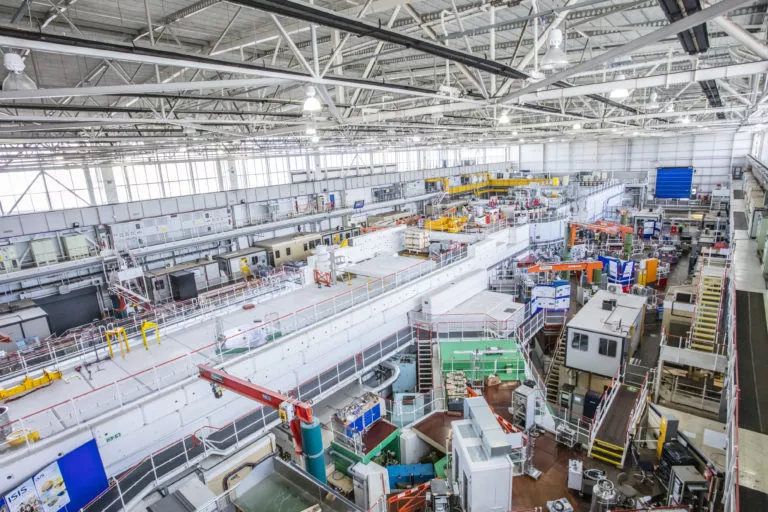
What do cancer research, chocolate and spiders' webs have in common?
Way point #10 Fermi Avenue
Well done for reaching the furthermost point of the Harwell Heritage Trail and here we pause for a moment to find out more about how tiny particles can be used to learn more about the world around us. Please prepare to be taken into space very shortly.
Harwell has a special science facility called the ISIS Neutron and Muon source based here at the Rutherford Appleton Laboratory (RAL). The name ISIS comes from the Egyptian goddess of regeneration and is the name of the River Thames, where it runs through Oxford.
ISIS Pulsed Neutron and Muon Facility conducts research into the physical and life sciences and is owned and operated by UKRI-STFC. The facility produces beams of neutrons and muons enabling scientists to study materials at the atomic level using a suite of instruments described as ‘super-microscopes’. The experiments carried out at ISIS provide detailed insights into the arrangement and behaviour of atoms and molecules in a material, which cannot be achieved by other methods.
A neutron is a subatomic particle without an electric charge, present in all atomic nuclei except those of ordinary hydrogen. A muon is a more exotic particle, with a lifetime of only a few micro-seconds. By using these particles, researchers from all over the world come to ISIS to study materials relevant to many scientific disciplines including physics, chemistry, engineering, materials science, environmental and geological sciences and, increasingly, the life sciences.
In addition to using ISIS, many of the researchers use one of the other facilities at Harwell as the ability to be able to measure the same sample using multiple techniques in one location is of huge benefit to researchers.
As well as seeking answers to important questions such as how to cure cancer, reduce carbon emissions and make better batteries, ISIS has assisted manufacturers in improving their products. Industrial users have investigated new fabric conditioners, pesticides, fuel additives and Maltesers, the chocolates that don’t melt in your hand. The facility is able to test the resilience of electronics to cosmic radiation and ISIS also conducts important conservation work, for example the preservation of ancient Persian swords for the Wallace Collection.
ISIS explores deep into the natural world, studying the tensile strength of spiders’ webs, why frogs don’t freeze and what we can learn from polar bear fur when developing new paints. Nature often holds the secrets to new innovations for mankind but needs to be viewed at the atomic level to be fully understood.
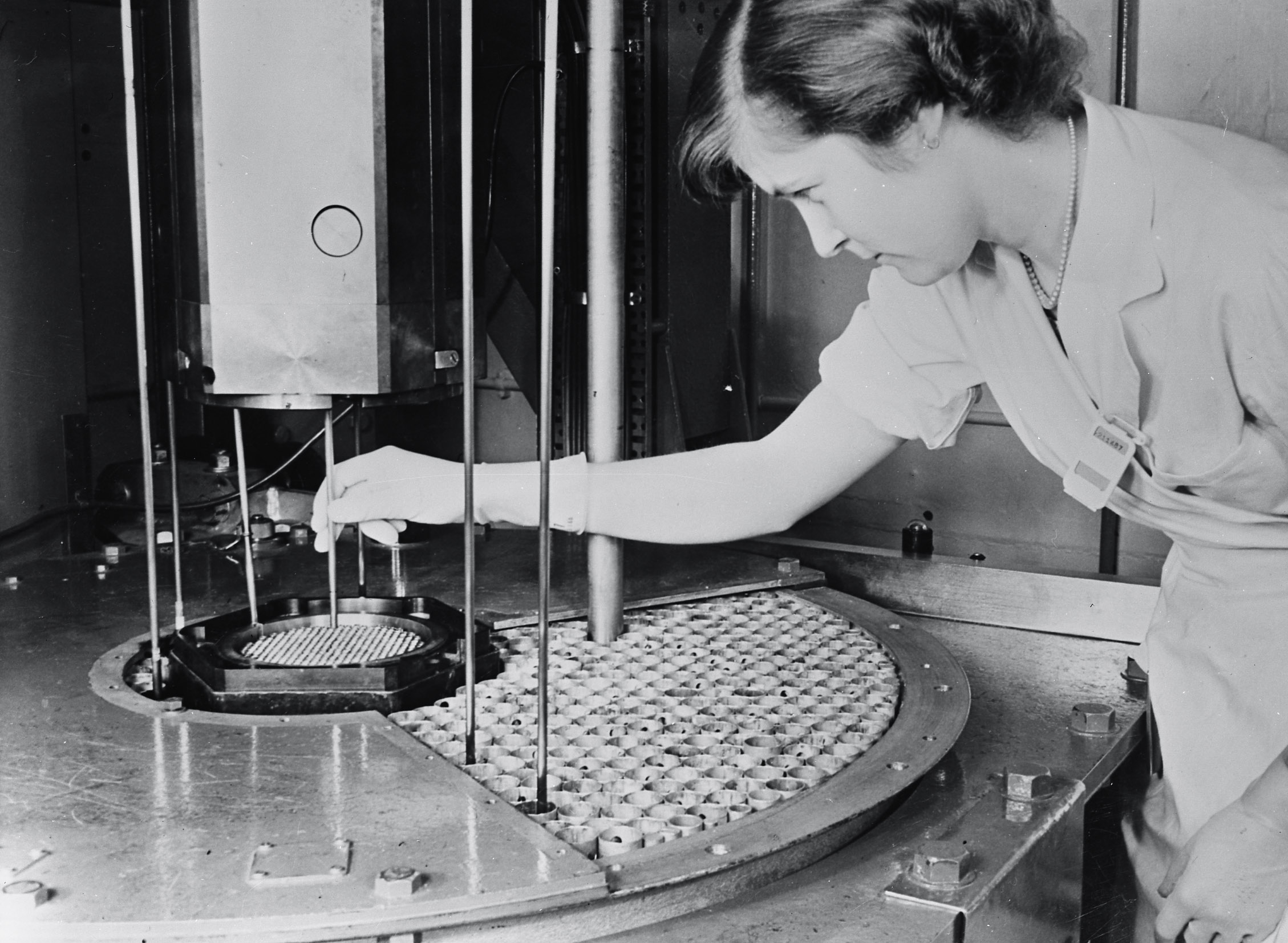
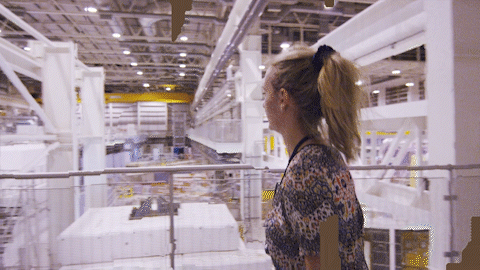
Women scientists blaze a trail
Way point #11 Fermi Avenue
There are only three stops remaining and here we want to pay homage to the extraordinary, clever people who have worked at Harwell over the last 75 years, exploring every aspect of our world and how we can make it a better place for everyone. We would like to shine spotlights on Dr Mary Lyon and Rosalind Franklin, two female scientists who have made a huge contribution towards scientific advancement at Harwell.
The Medical Research Council (MRC) was one of the first research facilities on campus, with a Radiobiology Unit that opened in 1947. Mary Lyon was employed by the MRC to conduct research on radiation hazards but in 1961 she published her theory on ‘X-chromosome inactivation’ whereby one copy of the X-chromosome is randomly inactivated in female cells. This prevents female cells from having twice as many gene products from the X-chromosome, as male cells, a process later known as Lyonization in her honour. Mary Lyon’s discovery was based on her love of cats and her desire to understand the origins of their tortoiseshell colouration. We now know that the genes for black and orange fur, responsible for tortoiseshell colouration, are on the X-chromosome.
Mary Lyon went on to establish the first frozen embryo archive, which is now a worldwide genetic resource of mouse models of human disease and the Mary Lyon Centre at MRC Harwell (a state-of-the-art mouse facility) is named after her. As a centre of excellence in mammalian genetics, MRC Harwell has furthered the understanding of many medical conditions such as glue ear in children, obesity, neurodegeneration, and developmental disorders.
Imagine a world where healthy human cells can be modified into super-power cells that can fight almost any disease when introduced into the body. This is one of the bold ideas of the Rosalind Franklin Institute, ‘The Franklin’, a national research institute which opened in 2021, and is dedicated to developing new technologies for tackling important health research challenges and unlocking new innovations. Rosalind Franklin’s own crystallography work provided a greater understanding of DNA, leading to later discoveries about the structure and importance of DNA’s double helical structure, made famous by Watson and Crick. Her work is commemorated in the name of the building and the helix graphic on the side of it.
The Franklin works with leading universities and industry partners to provide routes to commercialisation and the adoption of new, innovative technologies, , using state-of-the-art equipment including a building with specially stabilised foundations to enable the most delicate research to be undertaken.

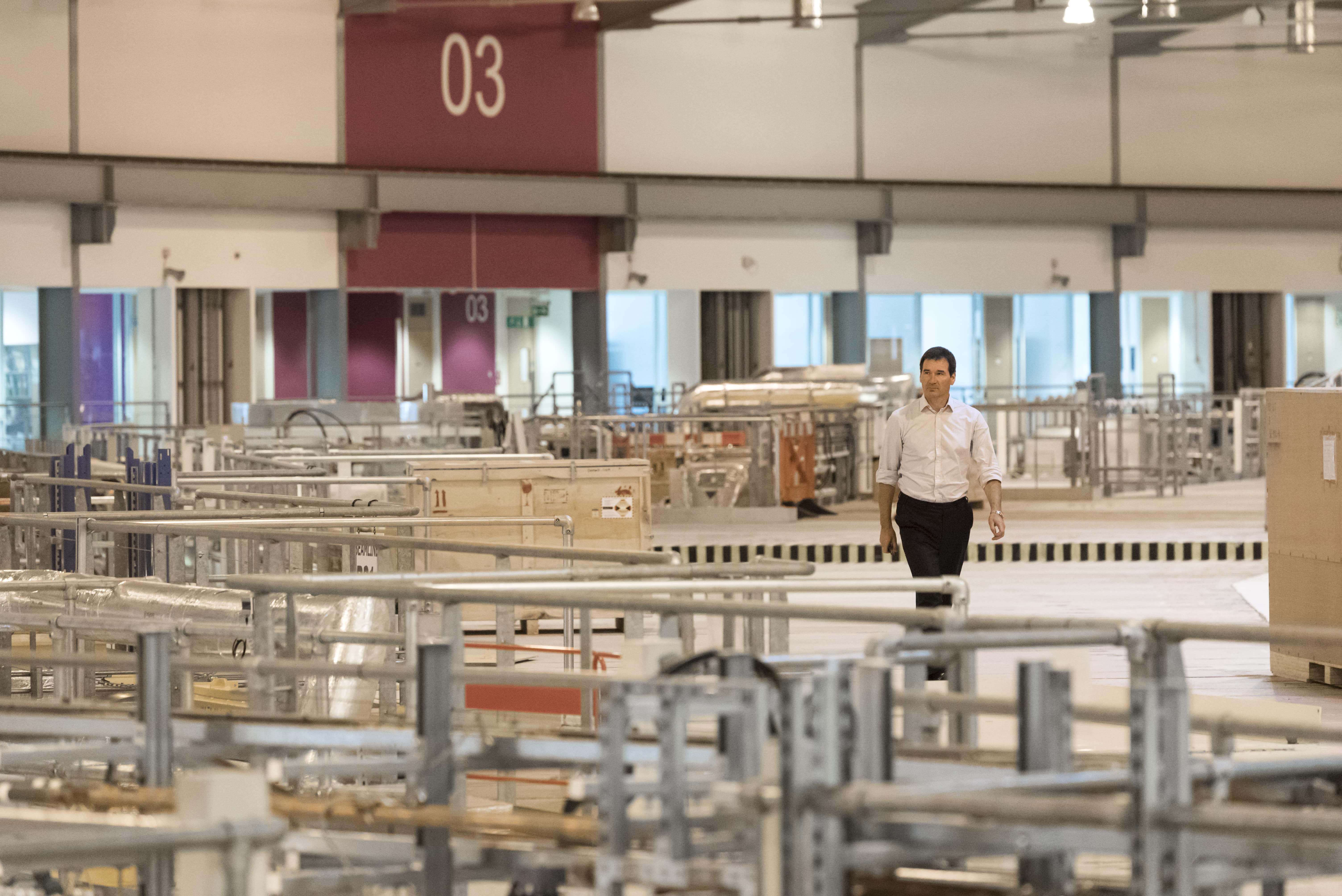
Shining a light on the UK's national synchrotron
Way point #12 Fermi Avenue
It’s time to put on your sunglasses as you prepare to be dazzled by facts about Diamond Light Source, the UK’s national synchrotron facility, at your penultimate stop.
Many of you may have heard of the Large Hadron Collider at CERN, in Switzerland which is the world’s most powerful synchrotron-type accelerator. Most developed countries have a synchrotron for research and the UK’s is here at Harwell.
The Diamond synchrotron produces light 10 billion times brighter than the Sun to study matter and material at the molecular and atomic level. The machine is 562m in circumference and has an iconic toroidal shape. The entire building covers an area the size of five football pitches, and it is the largest scientific instrument to be built in the UK. It acts like a giant microscope, focusing intense light beams at samples to study them in super fine detail. Firing electrons around a vast ring at almost the speed of light, and bending them with large magnets, creates brilliant beams of X-rays that can be used to look in great depth and detail at scientific samples, illuminating the world around us.
Diamond scientists and visiting researchers use the light to study a vast range of subject matter, from foot and mouth disease viruses to priceless paintings, tiny fractures in commercial aircraft propellers, the Herculaneum Scrolls and cannonballs from Henry VIII’s favourite ship, The Mary Rose. Diamond’s work has enabled the development of new drugs, the conservation of important artefacts and an array of other scientific breakthroughs. Since the beginning of the pandemic, Diamond has been involved in many different COVID-19 research projects and continues to help contribute to the latest understanding of the virus, its mutations and vaccine development.

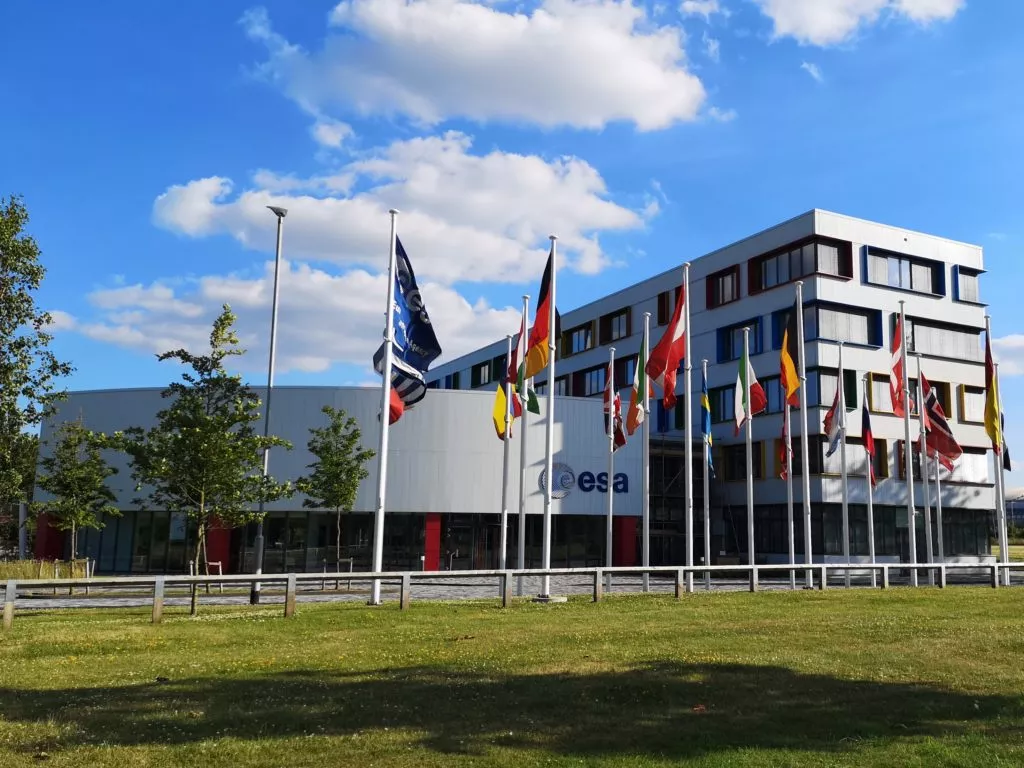
Harwell blasts into space
Way point #13 Fermi Avenue
Congratulations, you have reached the final stop on the Heritage Trail, so prepare to lift off as we introduce you to the Space Cluster at Harwell. This comprises a group of over 100 companies and other organisations dedicated to space related exploration and technologies which have grown up over the last 20 years around RAL Space, part of the Science and Technology Facilities Council and the UKRI’s space hub.
Look out for the European Space Agency (ESA), with the flags in front of the building, which opened in 2015. ESA formed part of the Rosetta space mission which remotely chased the Jupiter-family comet 67P/Churyumov-Gerasimenko for 10 years, successfully orbiting and landing on the comet. In November 2014, Rosetta’s lander ‘Philae’ was deployed to the comet surface to conduct a data gathering exercise and in August 2015 the mission ended with a controlled landing on the comet’s surface.
Harwell has the largest cluster of key space organisations in the UK and famous names include the Satellite Applications Catapult, Thales Alenia Space, Open Cosmos, Oxford Space Systems and Astroscale. On the opposite side of the road is the space test and calibration facility R100 and looking back from where you are now, you will see RAL Space’s National Satellite Test Facility, providing large-scale space test capabilities. These organisations are engaged in a wide range of activities from collecting space debris (space junk) out in space, to Earth Observation, gathering climate change data, tracking weather patterns, measuring ocean temperatures, identifying penguin colonies and gathering ice-melt statistics.
Satellites send information back to earth from space about everything from weather conditions to where we are located (GPS Navigation) and our favourite satellite TV programmes, so are very important. They can be very large or smaller, such as ‘Cubesats’ the size of a washing machine. Satellites are also used to protect marine conservation reserves to prevent over-fishing, vital to communities relying on food sustainability.
